Guangtao Zeng
Satori-SWE: Evolutionary Test-Time Scaling for Sample-Efficient Software Engineering
May 29, 2025Abstract:Language models (LMs) perform well on standardized coding benchmarks but struggle with real-world software engineering tasks such as resolving GitHub issues in SWE-Bench, especially when model parameters are less than 100B. While smaller models are preferable in practice due to their lower computational cost, improving their performance remains challenging. Existing approaches primarily rely on supervised fine-tuning (SFT) with high-quality data, which is expensive to curate at scale. An alternative is test-time scaling: generating multiple outputs, scoring them using a verifier, and selecting the best one. Although effective, this strategy often requires excessive sampling and costly scoring, limiting its practical application. We propose Evolutionary Test-Time Scaling (EvoScale), a sample-efficient method that treats generation as an evolutionary process. By iteratively refining outputs via selection and mutation, EvoScale shifts the output distribution toward higher-scoring regions, reducing the number of samples needed to find correct solutions. To reduce the overhead from repeatedly sampling and selection, we train the model to self-evolve using reinforcement learning (RL). Rather than relying on external verifiers at inference time, the model learns to self-improve the scores of its own generations across iterations. Evaluated on SWE-Bench-Verified, EvoScale enables our 32B model, Satori-SWE-32B, to match or exceed the performance of models with over 100B parameters while using a few samples. Code, data, and models will be fully open-sourced.
Satori: Reinforcement Learning with Chain-of-Action-Thought Enhances LLM Reasoning via Autoregressive Search
Feb 04, 2025



Abstract:Large language models (LLMs) have demonstrated remarkable reasoning capabilities across diverse domains. Recent studies have shown that increasing test-time computation enhances LLMs' reasoning capabilities. This typically involves extensive sampling at inference time guided by an external LLM verifier, resulting in a two-player system. Despite external guidance, the effectiveness of this system demonstrates the potential of a single LLM to tackle complex tasks. Thus, we pose a new research problem: Can we internalize the searching capabilities to fundamentally enhance the reasoning abilities of a single LLM? This work explores an orthogonal direction focusing on post-training LLMs for autoregressive searching (i.e., an extended reasoning process with self-reflection and self-exploration of new strategies). To achieve this, we propose the Chain-of-Action-Thought (COAT) reasoning and a two-stage training paradigm: 1) a small-scale format tuning stage to internalize the COAT reasoning format and 2) a large-scale self-improvement stage leveraging reinforcement learning. Our approach results in Satori, a 7B LLM trained on open-source models and data. Extensive empirical evaluations demonstrate that Satori achieves state-of-the-art performance on mathematical reasoning benchmarks while exhibits strong generalization to out-of-domain tasks. Code, data, and models will be fully open-sourced.
SailCompass: Towards Reproducible and Robust Evaluation for Southeast Asian Languages
Dec 02, 2024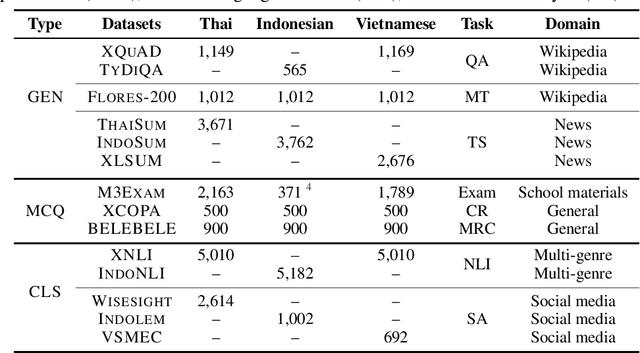
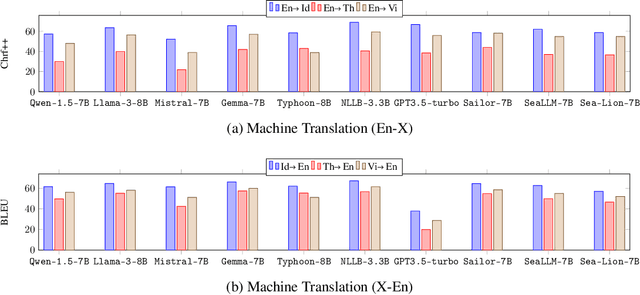

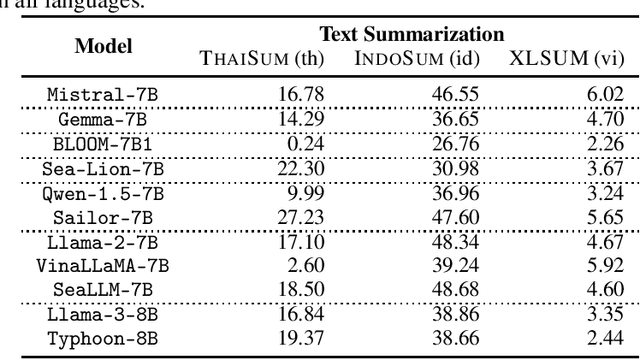
Abstract:In this paper, we introduce SailCompass, a reproducible and robust evaluation benchmark for assessing Large Language Models (LLMs) on Southeast Asian Languages (SEA). SailCompass encompasses three main SEA languages, eight primary tasks including 14 datasets covering three task types (generation, multiple-choice questions, and classification). To improve the robustness of the evaluation approach, we explore different prompt configurations for multiple-choice questions and leverage calibrations to improve the faithfulness of classification tasks. With SailCompass, we derive the following findings: (1) SEA-specialized LLMs still outperform general LLMs, although the gap has narrowed; (2) A balanced language distribution is important for developing better SEA-specialized LLMs; (3) Advanced prompting techniques (e.g., calibration, perplexity-based ranking) are necessary to better utilize LLMs. All datasets and evaluation scripts are public.
Scaling up Masked Diffusion Models on Text
Oct 24, 2024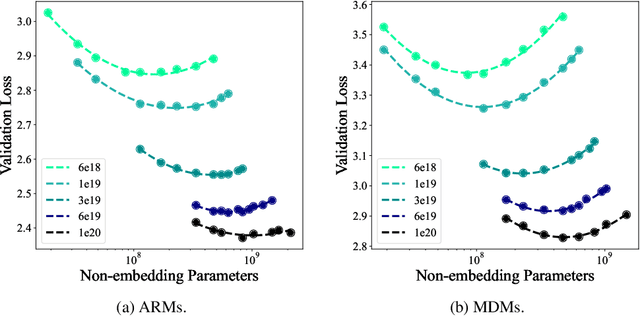

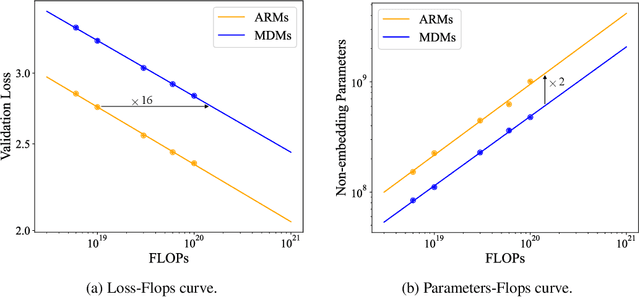

Abstract:Masked diffusion models (MDMs) have shown promise in language modeling, yet their scalability and effectiveness in core language tasks, such as text generation and language understanding, remain underexplored. This paper establishes the first scaling law for MDMs, demonstrating a scaling rate comparable to autoregressive models (ARMs) and a relatively small compute gap. Motivated by their scalability, we train a family of MDMs with up to 1.1 billion (B) parameters to systematically evaluate their performance against ARMs of comparable or larger sizes. Fully leveraging the probabilistic formulation of MDMs, we propose a simple yet effective \emph{unsupervised classifier-free guidance} that effectively exploits large-scale unpaired data, boosting performance for conditional inference. In language understanding, a 1.1B MDM shows competitive results, outperforming the larger 1.5B GPT-2 model on four out of eight zero-shot benchmarks. In text generation, MDMs provide a flexible trade-off compared to ARMs utilizing KV-cache: MDMs match the performance of ARMs while being 1.4 times faster, or achieve higher quality than ARMs at a higher computational cost. Moreover, MDMs address challenging tasks for ARMs by effectively handling bidirectional reasoning and adapting to temporal shifts in data. Notably, a 1.1B MDM breaks the \emph{reverse curse} encountered by much larger ARMs with significantly more data and computation, such as Llama-2 (13B) and GPT-3 (175B). Our code is available at \url{https://github.com/ML-GSAI/SMDM}.
Effi-Code: Unleashing Code Efficiency in Language Models
Oct 14, 2024Abstract:As the use of large language models (LLMs) for code generation becomes more prevalent in software development, it is critical to enhance both the efficiency and correctness of the generated code. Existing methods and models primarily focus on the correctness of LLM-generated code, ignoring efficiency. In this work, we present Effi-Code, an approach to enhancing code generation in LLMs that can improve both efficiency and correctness. We introduce a Self-Optimization process based on Overhead Profiling that leverages open-source LLMs to generate a high-quality dataset of correct and efficient code samples. This dataset is then used to fine-tune various LLMs. Our method involves the iterative refinement of generated code, guided by runtime performance metrics and correctness checks. Extensive experiments demonstrate that models fine-tuned on the Effi-Code show significant improvements in both code correctness and efficiency across task types. For example, the pass@1 of DeepSeek-Coder-6.7B-Instruct generated code increases from \textbf{43.3\%} to \textbf{76.8\%}, and the average execution time for the same correct tasks decreases by \textbf{30.5\%}. Effi-Code offers a scalable and generalizable approach to improving code generation in AI systems, with potential applications in software development, algorithm design, and computational problem-solving. The source code of Effi-Code was released in \url{https://github.com/huangd1999/Effi-Code}.
RegMix: Data Mixture as Regression for Language Model Pre-training
Jul 01, 2024Abstract:The data mixture for large language model pre-training significantly impacts performance, yet how to determine an effective mixture remains unclear. We propose RegMix to automatically identify a high-performing data mixture by formulating it as a regression task. RegMix involves training a set of small models with diverse data mixtures and fitting a regression model to predict their performance given their respective mixtures. With the fitted regression model, we simulate the top-ranked mixture and use it to train a large-scale model with orders of magnitude more compute. To empirically validate RegMix, we train 512 models with 1M parameters for 1B tokens of different mixtures to fit the regression model and find the optimal mixture. Using this mixture we train a 1B parameter model for 25B tokens (i.e. 1000x larger and 25x longer) which we find performs best among 64 candidate 1B parameter models with other mixtures. Further, our method demonstrates superior performance compared to human selection and achieves results that match or surpass DoReMi, while utilizing only 10% of the compute budget. Our experiments also show that (1) Data mixtures significantly impact performance with single-task performance variations of up to 14.6%; (2) Web corpora rather than data perceived as high-quality like Wikipedia have the strongest positive correlation with downstream performance; (3) Domains interact in complex ways often contradicting common sense, thus automatic approaches like RegMix are needed; (4) Data mixture effects transcend scaling laws, and our approach captures the complexity by considering all domains together. Our code is available at https://github.com/sail-sg/regmix.
Long Context Transfer from Language to Vision
Jun 24, 2024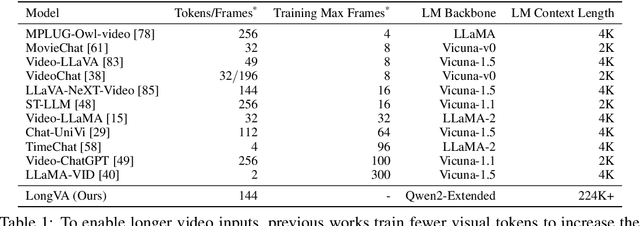
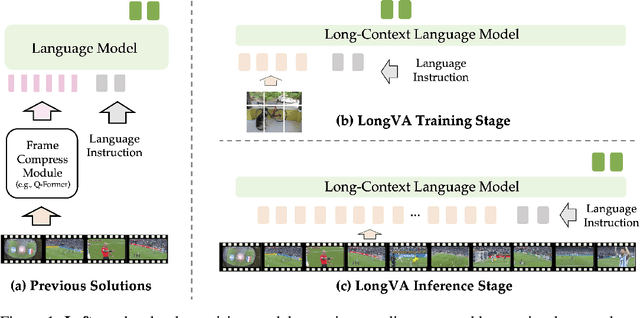
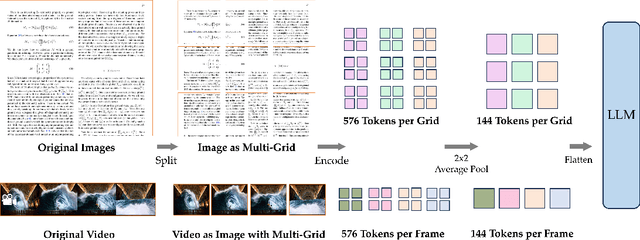

Abstract:Video sequences offer valuable temporal information, but existing large multimodal models (LMMs) fall short in understanding extremely long videos. Many works address this by reducing the number of visual tokens using visual resamplers. Alternatively, in this paper, we approach this problem from the perspective of the language model. By simply extrapolating the context length of the language backbone, we enable LMMs to comprehend orders of magnitude more visual tokens without any video training. We call this phenomenon long context transfer and carefully ablate its properties. To effectively measure LMMs' ability to generalize to long contexts in the vision modality, we develop V-NIAH (Visual Needle-In-A-Haystack), a purely synthetic long vision benchmark inspired by the language model's NIAH test. Our proposed Long Video Assistant (LongVA) can process 2000 frames or over 200K visual tokens without additional complexities. With its extended context length, LongVA achieves state-of-the-art performance on Video-MME among 7B-scale models by densely sampling more input frames. Our work is open-sourced at https://github.com/EvolvingLMMs-Lab/LongVA.
Sailor: Open Language Models for South-East Asia
Apr 04, 2024Abstract:We present Sailor, a family of open language models ranging from 0.5B to 7B parameters, tailored for South-East Asian (SEA) languages. These models are continually pre-trained from Qwen1.5, a great language model for multilingual use cases. From Qwen1.5, Sailor models accept 200B to 400B tokens, primarily covering the languages of English, Chinese, Vietnamese, Thai, Indonesian, Malay, and Lao. The training leverages several techniques, including BPE dropout for improving the model robustness, aggressive data cleaning and deduplication, and small proxy models to optimize data mixture. Experimental results on four typical tasks indicate that Sailor models demonstrate strong performance across different benchmarks, including commonsense reasoning, question answering, reading comprehension and examination. Embracing the open-source spirit, we share our insights through this report to spark a wider interest in developing large language models for multilingual use cases.
TinyLlama: An Open-Source Small Language Model
Jan 04, 2024



Abstract:We present TinyLlama, a compact 1.1B language model pretrained on around 1 trillion tokens for approximately 3 epochs. Building on the architecture and tokenizer of Llama 2, TinyLlama leverages various advances contributed by the open-source community (e.g., FlashAttention), achieving better computational efficiency. Despite its relatively small size, TinyLlama demonstrates remarkable performance in a series of downstream tasks. It significantly outperforms existing open-source language models with comparable sizes. Our model checkpoints and code are publicly available on GitHub at https://github.com/jzhang38/TinyLlama.
Towards a Mechanistic Interpretation of Multi-Step Reasoning Capabilities of Language Models
Oct 23, 2023
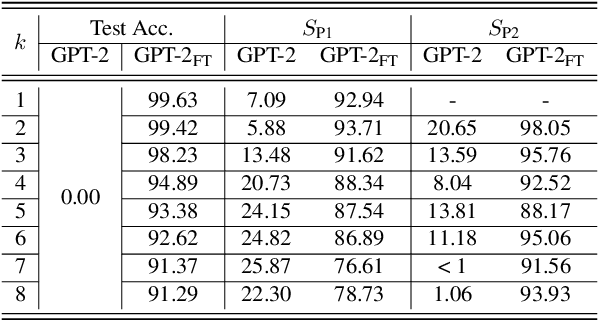

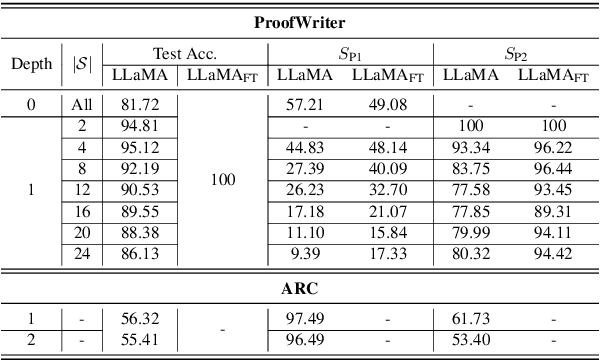
Abstract:Recent work has shown that language models (LMs) have strong multi-step (i.e., procedural) reasoning capabilities. However, it is unclear whether LMs perform these tasks by cheating with answers memorized from pretraining corpus, or, via a multi-step reasoning mechanism. In this paper, we try to answer this question by exploring a mechanistic interpretation of LMs for multi-step reasoning tasks. Concretely, we hypothesize that the LM implicitly embeds a reasoning tree resembling the correct reasoning process within it. We test this hypothesis by introducing a new probing approach (called MechanisticProbe) that recovers the reasoning tree from the model's attention patterns. We use our probe to analyze two LMs: GPT-2 on a synthetic task (k-th smallest element), and LLaMA on two simple language-based reasoning tasks (ProofWriter & AI2 Reasoning Challenge). We show that MechanisticProbe is able to detect the information of the reasoning tree from the model's attentions for most examples, suggesting that the LM indeed is going through a process of multi-step reasoning within its architecture in many cases.
 Add to Chrome
Add to Chrome Add to Firefox
Add to Firefox Add to Edge
Add to Edge